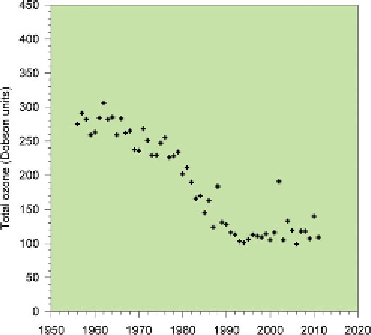Geoscience Reference
In-Depth Information
Figure 11.5 The lowest ozone values recorded at Halley
Antarctic in October of each year. A Dobson unit is the
thickness of the column of atmosphere if all ozone were
compressed to 1 standard atmospheric pressure
(~101 kPa) at 0
C, i.e. 200DU¼2mm.
many low-lying areas will not be possible;
managed retreat will be required, thus creating
large numbers of environmental refugees.
Accurate predictions of sea-level rise are essential
to determine the optimum adaption strategies,
and studies of the cryosphere in the polar
regions have a critical contribution to make.
The ozone hole: lessons learned, problem solved?
The ozone hole was
first described in an historic paper by British Antarctic
Survey scientists in 1985 using measurements from Halley, Antarctica. The ozone
hole is where most of the ozone in the stratosphere (~20 km altitude) over
Antarctica disappears in the austral spring with a slow recovery in the summer.
The minimum ozone concentrations observed in spring fell throughout the 1980s,
and reached a minimum in the early 1990s but with considerable year-to-year
variability. The
finding of the ozone hole stimulated a considerable amount of
new research, and its cause was quickly understood.
It is caused by chloro
uorocarbons (CFCs) used largely as a refrigerant and as a
propellant in aerosols mainly in the northern hemisphere. But the largest impacts are
seen in the most distant region of the planet. This is because the atmosphere below
about 100 km altitude mixes very rapidly on the timescale of a year, thus polluting gases
get transported quickly around the world. The Antarctic stratosphere, where the ozone
hole forms, is much colder than anywhere else, making it an ideal location for the
necessary chemical reactions to occur. The
finding of the ozone hole was a sudden
wake-up call to many people, as it demonstrated how humans could affect the planet
in ways that were not predicted and through impacts that were not necessarily local.
What was equally remarkable was that within 28months of the ozone hole
paper being published, the Montreal Protocol on Ozone Depleting Substances was
negotiated and signed by 24 countries, and the European Economic Community in
September 1987. The Protocol was strengthened by a series of additional measures
signed in London (1990), Copenhagen (1992) and Montreal (1997). This meant that
CFC production was phased out in developed countries by 1995, and by 2010 for
developing countries. The 16 September 2009 was an historic date
-
Timor-Leste




Search WWH ::

Custom Search